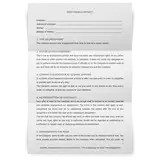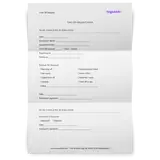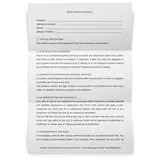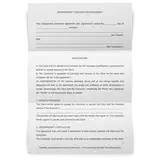If you need to write a letter of termination, but are unsure of how or where to start, this letter of termination template is a great resource to help you write a personable, professional letter that will best represent your company.
Here’s a sample Letter of Termination template that can be easily customized and adapted to meet your requirements. It’s free to download and use.
Why Write a Letter of Termination?
Terminating an employee is never easy. However, it is important to maintain professionalism during the process. Writing a letter of termination is not only professional, but it also creates a legal record of the termination, which will help your company in the event of any potential legal issues. Proper documentation is crucial, and a clear, legal letter is often the first step.
A professional letter ensures the employee understands why they were terminated and provides them with all of the relevant information they will need after their time with your company has ended. Not to mention, providing such a document protects your company’s reputation as one who takes care of its employees.
Letter of Termination Template
Use the above template to craft your letter, tailored to your specific needs, for your specific company. It can be adapted for any situation involving the termination of any employee - including layoffs, termination with cause, performance issues, and the end of contractual obligations. Add your company’s specific information in place of the template’s bracketed words, and your letter will be ready to print, email, and save.
Writing a Letter of Termination
The above template is straightforward, concise, and provides all of the necessary and needed information - professionally written and ready to use. To write yours, personalize the template by following these steps:
- Address the employee in question by full name and state the date of termination in the letter’s first full sentence. Not only does this immediately express the intent of the letter, but it also establishes the effective date of termination with no room for confusion. Remember to state the finality of the decision, as it indicates that you have gone through multiple steps before reaching termination, and allows no further discussion.
- List the specific reasons for the termination of this employee. Be clear and concise in your explanation. You want to detail why the employee is being terminated, but you want to explain in a way that avoids confusion. Be sure also to include any evidence that has led to the decision, including previous disciplinary actions, progress reports, etc. When using this letter of termination template, each of your reasons and the appropriate explanations should be listed as separate paragraphs, to avoid confusion.
- As appropriate to your company, be sure to list and describe any remaining compensation they are entitled to, including remaining vacation days, paid leave, and any other accrued compensation. Additionally, be sure to list when they will receive this compensation, and if it will be contingent upon any other condition (returning of company equipment, exit interview, etc.).
- State your company’s policy on continuing health care for a terminated employee, and when their benefits will end. This letter of termination of employment template mentions COBRA. If your company falls under the Consolidated Budget Reconciliation Act (COBRA), be sure to offer your employee the information on pursuing COBRA coverage.
- Include the necessary information for the terminated employee to retrieve any retirement accounts they have with your company, and any additional information, if applicable, regarding your company and retirement benefits.
- Request the employee return any company equipment that they would have for their job. This can include laptops, keys, proprietary books and/or software, or anything else they might have to return. Be sure to state how they are to return the items, specifically where and to whom should the items be returned to, and by what date.
- If your company has any signed agreements with the terminated employee, be sure to remind them at this time, and include copies to avoid any potential confusion. This termination letter template includes non-disclosure and non-compete agreements, but this can include any signed agreements your company has with the employee in question. You should print these documents after you have customized your letter and attach them to an email when you send it to the employee.
- Provide the contact information of the appropriate HR manager to receive any potential questions regarding the termination. This HR manager should have all of the answers to the above points.
- Finish with your name. Keep it professional. Though terminating an employee can be uncomfortable, remember that you represent the company’s reputation, and a professional letter is an optimum answer to an unfortunate aspect of business. This letter of termination template states to sign off with the manager handling the termination, but this can also include any other pertinent individuals, including the owner, human resource managers, and department managers.
Tips to Remember
When drafting your employee termination letter, be sure to meet with your company’s legal department to ensure that you have included all necessary information for your locality. Different states have different labor laws, so be sure to confirm your letter conforms to the local requirements.
Not every termination has to mean the end of the relationship with that employee. A letter of termination creates a lasting relationship of respect between your company and the employee. And even if the termination was justified, it is prudent to maintain a vast network of contacts.
By using this termination of employment letter template, you will be able to customize your sample termination letter to fit the specific details of your company and the employee(s) in question, as it is adaptable to your company’s size, specific policies, benefit offerings, and any other pertinent information. It can be used for several scenarios - this template assures the vital information is present while allowing you to add any personal additions you would like.
Treat the above template as a guide. Be sure to add your natural voice to your letter. Terminations are unfortunate and awkward, but professionalism is key. Write concise sentences. Be genuine with your words - don’t use filler or inflated words for effect. This letter of termination sample is intended to serve as a base to build upon, following your company identity, the appropriate laws you must adhere to, and the necessities of your legal and human resources departments.
Finally, remember that this letter is a direct representation of your company, your employees, your reputation, and yourself. Despite its negative content, it should reflect the high standard of your company.
Myth busting: common misconceptions about termination letters in HR
Termination letters are an essential part of the employee separation process, but several misconceptions can lead to misunderstandings. Let's address and clarify five common myths related to termination letters to enhance your understanding of this important HR tool.
Myth 1: termination letters are not necessary
Clarification: A termination letter is crucial for formally documenting the end of an employment relationship. It serves as an official document that outlines the reasons for termination of employment, the termination date, and any relevant details such as severance pay or the return of company property. This clarity helps prevent disputes and ensures compliance with state and local laws.
Myth 2: a termination letter only needs to state the termination
Clarification: While it is important to clearly state the employee's termination, a comprehensive termination letter should also address other key aspects. This includes details about the final paycheck, instructions for returning company property, information about employee benefits, and any applicable confidentiality agreements. Including these details helps ensure a smooth and legally compliant termination process.
Myth 3: termination letters are the same for all situations
Clarification: Termination letters should be tailored to the specific circumstances of each case. Whether the termination is due to poor performance, falsifying company records, or other reasons, the letter should reflect the specific reasons and reference any relevant company policies. Customizing the employee termination form ensures it accurately represents the situation and provides clear documentation.
Myth 4: once a termination letter is issued, no further communication is needed
Clarification: Issuing an employment termination letter is just one step in the termination process. It is important to provide opportunities for the employee to ask questions and understand the details of their termination. Providing contact details for a company representative or legal counsel ensures that the employee has a clear point of contact for any follow-up questions or concerns.
Myth 5: termination letters do not need to follow legal guidelines
Clarification: Termination letters must comply with state and local laws to avoid legal issues. This includes adhering to regulations regarding final paycheck distribution, addressing severance pay, and ensuring that the termination is documented in accordance with company and legal standards. Consulting with legal counsel can help ensure that your termination letters meet all necessary legal requirements.
By understanding these myths and the facts behind them, HR professionals can create more effective and compliant termination letters. Utilizing termination letter samples and tailoring them to specific situations can help ensure clarity and legal compliance, ultimately contributing to a smoother termination process.
![Cut Ties Properly With This Letter Of Termination Template [Free Download]](/static/image?src=https%3A%2F%2Fcdnblog.unrubble.com%2Fpayload-unrubble-images%2FLetter-Of-Termination-Template-600x600.png&width=512&height=512&fit=contain&position=center&quality=65&compressionLevel=9&loop=0&delay=100&crop=null&contentType=image%2Fwebp)




